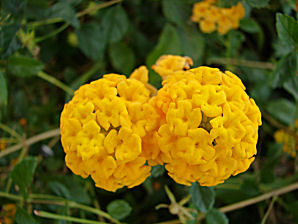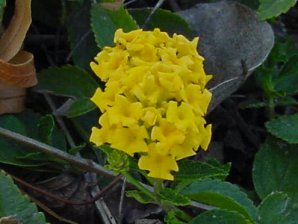Arizona Wild Flowers
Pictures, Photos, Images
Descriptions, Information, Reviews.
Gold Lantana, Lantana camara.
We Are Proud Of Our SafeSurf Rating!
Click On Any Of The Following Links By Amazon.Com
For Books, & Videos About Wildflowers Of Arizona & The Southwest USA. No Obligation!
 |
| Gold Lantana, Lantana camara. |
|---|
 |  |
| New Gold Lantana, A New Hybred Lantana camara. | Best Selling Lantana In USA. |
|---|
Gold Lantana.
We wish to thank Wikipedia, the free encyclopedia for some of the information on this page. We share images and information with Wikipedia. There are over 100 subspecies of Lantana. Gold lantana has become the most popular landscaping plant in Arizona and the USA. During cold weather Lantana will appear not to be growing but will come back in warm weather. In general all Lantana's are extremely easy to grow requiring little attention and they are seldom bothered by pests or disease. They has low water requirements and can be used in xeriscapes and can handle the heat growing in containers and hanging baskets under sunny conditions. Lantana is a favorite species for butterflies and non-invasive lantanas should be a part of any butterfly garden. However, it is considered among the world's worst 100 Invasive Species. It naturally occurs in agricultural areas, coastland, disturbed areas, natural forest, planted forests, range/grasslands, riparian zones, scrub/shrublands, urban areas, wetlands It causes decreased productivity in pastures and it poisons cattle. It also invades disturbed natural ecosystems. However, it is an ideal Xeriscape Landscape Plant in Arizona.
Quick Notes:
Height: Up To about 28 inches tall and about 48 inches wide. Most from the nursary are about 8 inches to 10 inches in height.
Stalk: Woody when old, the sprawling stems are covered with rough hairs and emit an unpleasant aroma when crushed.
Flowers: The gold Yellow, small flowers are held in clusters (called umbels) that are typically 1 - 2 inches across.
Flowering Time: Late February - December.
Seeds: The seeds are almost circular, 1/2 inch or slightly more in diameter, brown to reddish brown, flattened, irregularly angled, with a finely pitted surface.
Leaves: Leaves are covered with rough hairs and emit an unpleasant aroma when crushed. They are simple, ovate or ovate-oblong, acute or subacute, crenate-serrate, rugose above, scabrid on both sides.
Found: Native to Mexico, Central America, the Greater Antilles, The Bahamas, Colombia, and Venezuela. Native to the Lower Rio Grande Valley of Texas in the United States. The USDA claims it is native to the USA (AL, AZ, CA, FL, GA, HI, LA, MS, NC, OK, SC, TX, UT), USA+ (PR, VI).
Hardiness:
Soil pH requirements:
Sun Exposure:
Elevation: 0 - 4,900 Feet.
Habitat: Well drained soil is preferred. Lantana is very drought resistant. This tropical plant is killed back to the ground at 28 �F but will grow back from the roots when warm weather returns.
Miscellaneous: Flowering Photos Taken March 24, 2003. Glendale, Arizona..
|
We Are Proud Of Our SafeSurf Rating!
Click On Any Of The Following Links By Amazon.Com
For Books, & Videos About Wildflowers Of Arizona & The Southwest USA. No Obligation!
| © 1966 - Present, Audrey, Eve, & George DeLange |
